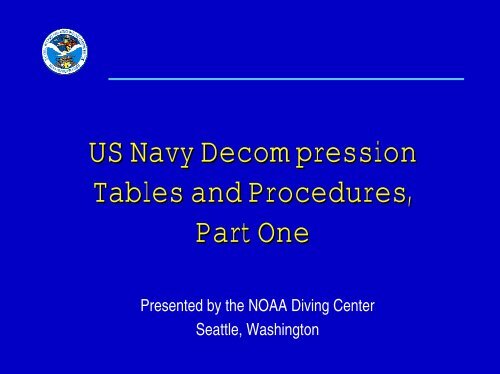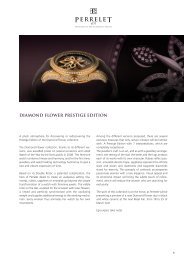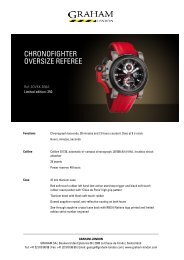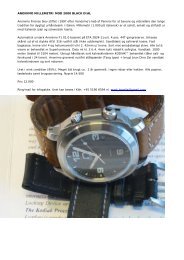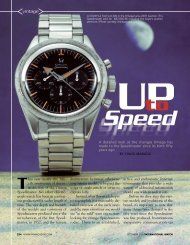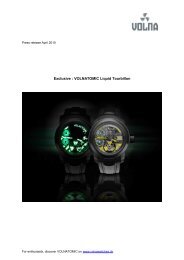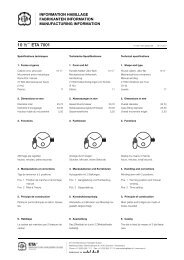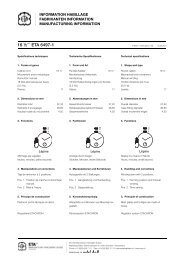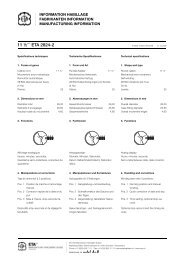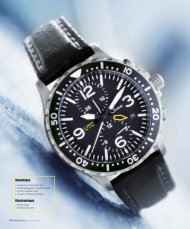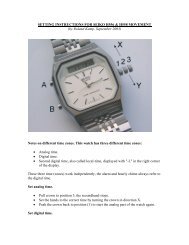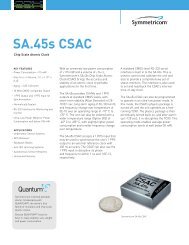USN Decompression Tables & Procedures.pdf - Watchuseek, World's ...
USN Decompression Tables & Procedures.pdf - Watchuseek, World's ...
USN Decompression Tables & Procedures.pdf - Watchuseek, World's ...
You also want an ePaper? Increase the reach of your titles
YUMPU automatically turns print PDFs into web optimized ePapers that Google loves.
US Navy <strong>Decompression</strong><br />
<strong>Tables</strong> and <strong>Procedures</strong>,<br />
Part One<br />
Presented by the NOAA Diving Center<br />
Seattle, Washington
Table development<br />
Definitions<br />
Rules<br />
No-decompression limits<br />
and Repetitive Group<br />
Designation table<br />
Global View View<br />
Residual nitrogen<br />
timetables<br />
Diagramming dives
What are decompression tables?<br />
Introduction-1<br />
Introduction<br />
– Depth and time limits used to plan and conduct dives in<br />
such a manner as to reduce the probability of<br />
decompression sickness.<br />
– <strong>Decompression</strong> tables take into consideration the amount<br />
of nitrogen absorbed by the body at various depths and<br />
times.<br />
– Other considerations are the allowable pressure gradients<br />
which can exist without excessive bubble formation and<br />
different gas elimination rates associated with various<br />
body tissues.
Introduction-2<br />
Introduction<br />
Development of the <strong>USN</strong> <strong>Decompression</strong> tables<br />
– 1915: First set of decompression tables developed by French<br />
and Stillson for the <strong>USN</strong> Bureau of Construction and<br />
Repair<br />
– 1935: Second generation tables developed by Hawkins,<br />
Shillings, and Hanson<br />
– 1937: Third generation tables developed by Yarborough<br />
– 1951: Fourth generation developed by Van Der Aue<br />
– 1956: Fifth generation tables developed by Des Granger,<br />
Dwyer, and Workman developed with a UNIVAC<br />
computer and tested with approximately 600 man-dives<br />
at the <strong>USN</strong> EDU
Introduction-3<br />
Introduction<br />
Development of the <strong>USN</strong> <strong>Decompression</strong> tables Con’t.<br />
– 1993: New probabilistic (versus deterministic)<br />
tables developed, but rejected by Naval Sea<br />
System Command (too conservative)<br />
– 1999: Latest version of <strong>USN</strong> Air <strong>Decompression</strong><br />
<strong>Tables</strong> released. Includes new tables for<br />
traveling to altitude following dives<br />
– Future: New Nitrox <strong>Tables</strong> are being developed
Table Definitions-1<br />
Definitions<br />
Depth: Maximum depth attained during a dive<br />
Actual Bottom Time (ABT): Time from leaving surface until<br />
beginning a direct ascent to the surface<br />
<strong>Decompression</strong>: Process of eliminating nitrogen from the body<br />
during ascent<br />
– Linear: One continuous ascent without stopping<br />
– Staged: Stops for specific times at specific depths during<br />
ascent<br />
No-<strong>Decompression</strong> limits: Maximum time that can be spent at a<br />
given depth without requiring staged decompression
Table Definitions-2<br />
Definitions<br />
<strong>Decompression</strong> schedule: List of decompression stops for a<br />
particular max. depth and bottom time, e. g., 100’/25<br />
Single dive: Any dive conducted more than 12 hours after a<br />
previous dive<br />
Surface Interval Time (SIT): Time spent at the surface<br />
between dives.<br />
Residual nitrogen: Amount of nitrogen gas remaining in a<br />
diver’s tissues following a dive<br />
Repetitive dive: Any dive conducted less than 12 hours after<br />
a previous dive.
Table Definitions-3<br />
Definitions<br />
Repetitive Group Designation (RGD): A letter that designates<br />
the amount of nitrogen remaining in a diver’s body during a<br />
12-hour period following a dive<br />
Residual Nitrogen Time (RNT): Time (minutes) that must be<br />
considered when calculating the bottom time of a repetitive<br />
dive to compensate for nitrogen remaining in a diver’s tissues<br />
from a previous dive.<br />
Equivalent Single Dive Time (ESDT): Time (minutes) used to<br />
select a schedule for a single repetitive dive. Equal to the<br />
bottom time of the planned repetitive dive plus the diver’s<br />
residual nitrogen time (ABT + RNT)
Dive Table Rules<br />
All dive schedules not specifically listed are covered in<br />
the tables by the next deeper and longer schedule<br />
Enter tables at the listed depth that is exactly equal to,<br />
or is the next greater depth than the maximum depth<br />
attained during a dive<br />
Select the bottom time that is exactly equal to, or is<br />
next greater than the bottom time of the dive<br />
The rate of ascent from the bottom to the surface and<br />
between decompression stops is 30 fpm
The U. S. Navy No-<br />
<strong>Decompression</strong> Limits<br />
and Repetitive Group<br />
Designation Table<br />
Summarizes all depth<br />
and bottom time<br />
combinations that do not<br />
require staged decompression<br />
Provides repetitive group designation<br />
(RGD) for each no-decompression<br />
dive<br />
<strong>USN</strong> No-Deco No Deco <strong>Tables</strong>-1 <strong>Tables</strong><br />
FSW MAX A B C D E F<br />
10 60 120 210 300 797 *<br />
15 35 70 110 160 225 350<br />
20 25 50 75 100 135 180<br />
25 595 20 35 55 75 100 125<br />
30 405 15 30 45 60 75 95<br />
35 310 5 15 25 40 50 60
<strong>USN</strong> No-Deco No Deco <strong>Tables</strong>-2 <strong>Tables</strong><br />
No-<strong>Decompression</strong> Limits and Repetitive Group Designation Table For No-<br />
<strong>Decompression</strong> Air Dives - 1999<br />
Depth Max A B C D E F G H I J K L M N O<br />
10 60 120 210 300 797 *<br />
15 35 70 110 160 225 350 452 *<br />
20 25 50 75 100 135 180 240 325 390 917 *<br />
25 595 20 35 55 75 100 125 160 195 245 315 361 540 595<br />
30 405 15 30 45 60 75 95 120 145 170 205 250 310 344 405<br />
35 310 5 15 25 40 50 60 80 100 120 140 160 190 220 270 310<br />
40 200 5 15 25 30 40 50 70 80 100 110 130 150 170 200<br />
50 100 10 15 25 30 40 50 60 70 80 90 100<br />
60 60 10 15 20 25 30 40 50 55 60<br />
70 50 5 10 15 20 30 35 40 45 50<br />
80 40 5 10 15 20 25 30 35 40<br />
90 30 5 10 12 15 20 25 30<br />
100 25 5 7 10 15 20 22 25<br />
110 20 5 10 13 15 20<br />
120 15 5 10 12 15<br />
130 10 5 8 10
Description:<br />
<strong>USN</strong> No-Deco No Deco <strong>Tables</strong>-3<br />
<strong>Tables</strong><br />
– First vertical column on far left lists various depths from 10<br />
to 190 fsw<br />
– Second vertical column from the left lists depths from 3 to<br />
59.9 meters<br />
– Third vertical column from the left indicates the maximum<br />
No-decompression Limits in minutes for each depth<br />
– Remaining vertical columns list specific bottom times<br />
ranging from 5 minutes To 917 minutes<br />
– Horizontal top row lists the repetitive group designation from<br />
A to O
Description, cont.<br />
<strong>USN</strong> No-Deco No Deco <strong>Tables</strong>-4 <strong>Tables</strong><br />
FSW MAX A B C D E F G H I J K L M N O<br />
10 60 120 210 300 797 *<br />
15 35 70 110 160 225 350 452 *<br />
20 25 50 75 100 135 180 240 325 390 917 *<br />
25 595 20 35 55 75 100 125 160 195 245 315 361 540 595<br />
30 405 15 30 45 60 75 95 120 145 170 205 250 310 344 405<br />
35 310 5 15 25 40 50 60 80 100 120 140 160 190 220 270 310<br />
– Depths shallower than 20 feet do not have a specific nodecompression<br />
limit. The <strong>USN</strong> determined that times listed were<br />
sufficient for any operational tasks required<br />
– Dives with times that exceed those listed on the table must use<br />
the <strong>USN</strong> Standard Air Table
Application:<br />
– Locate exact or next greater<br />
depth from vertical column on<br />
far left<br />
– Move horizontally to locate<br />
exact or next greater bottom<br />
time<br />
– Move vertically to the top of<br />
the page and read the<br />
repetitive group designation<br />
(RGD) letter<br />
<strong>USN</strong> No-Deco No Deco <strong>Tables</strong>-5<br />
<strong>Tables</strong><br />
FSW MAX A B C D E F<br />
10 60 120 210 300 797 *<br />
15 35 70 110 160 225 350<br />
20 25 50 75 100 135 180<br />
25 595 20 35 55 75 100 125<br />
30 405 15 30 45 60 75 95<br />
35 310 5 15 25 40 50 60<br />
40 200 5 15 25 30 40 50<br />
50 100 10 15 25 30 40<br />
60 60 10 15 20 25 30
Questions 1 and 2:<br />
<strong>USN</strong> No-Deco No Deco <strong>Tables</strong>-6<br />
<strong>Tables</strong><br />
– What is the max. no-decompression limit for a dive to 60<br />
feet?<br />
– What is the RGD for the 60’/:60 dive?<br />
FSW MAX A B C D E F G H I J K<br />
10 60 120 210 300 797 *<br />
15 35 70 110 160 225 350 452 *<br />
20 25 50 75 100 135 180 240 325 390 917 *<br />
25 595 20 35 55 75 100 125 160 195 245 315 361<br />
30 405 15 30 45 60 75 95 120 145 170 205 250<br />
35 310 5 15 25 40 50 60 80 100 120 140 160<br />
40 200 5 15 25 30 40 50 70 80 100 110 130<br />
50 100 10 15 25 30 40 50 60 70 80 90<br />
60 60 10 15 20 25 30 40 50 55 60
Answers to questions 1 and 2:<br />
Question #1: 60 minutes<br />
Question #1: 60 minutes<br />
<strong>USN</strong> No-Deco No Deco <strong>Tables</strong>-7 <strong>Tables</strong><br />
FSW MAX A B C D E F G H I J K<br />
10 60 120 210 300 797 *<br />
15 35 70 110 160 225 350 452 *<br />
20 25 50 75 100 135 180 240 325 390 917 *<br />
25 595 20 35 55 75 100 125 160 195 245 315 361<br />
30 405 15 30 45 60 75 95 120 145 170 205 250<br />
35 310 5 15 25 40 50 60 80 100 120 140 160<br />
40 200 5 15 25 30 40 50 70 80 100 110 130<br />
50 100 10 15 25 30 40 50 60 70 80 90<br />
60 60 10 15 20 25 30 40 50 55 60<br />
Question #2: RGD = J<br />
Question #2: RGD = J
Question #3:<br />
<strong>USN</strong> No-Deco No Deco <strong>Tables</strong>-8<br />
<strong>Tables</strong><br />
– What is the maximum no-decompression limit for a dive to 33<br />
feet?<br />
FSW MAX A B C D E F G H I J K L M N O<br />
10 60 120 210 300 797 *<br />
15 35 70 110 160 225 350 452 *<br />
20 25 50 75 100 135 180 240 325 390 917 *<br />
25 595 20 35 55 75 100 125 160 195 245 315 361 540 595<br />
30 405 15 30 45 60 75 95 120 145 170 205 250 310 344 405<br />
35 310 5 15 25 40 50 60 80 100 120 140 160 190 220 270 310<br />
40 200 5 15 25 30 40 50 70 80 100 110 130 150 170 200
Answer to question #3:<br />
<strong>USN</strong> No-Deco No Deco <strong>Tables</strong>-9<br />
<strong>Tables</strong><br />
FSW MAX A B C D E F G H I J K L M N O<br />
10 60 120 210 300 797 *<br />
15 35 70 110 160 225 350 452 *<br />
20 25 50 75 100 135 180 240 325 390 917 *<br />
25 595 20 35 55 75 100 125 160 195 245 315 361 540 595<br />
30 405 15 30 45 60 75 95 120 145 170 205 250 310 344 405<br />
35 310 5 15 25 40 50 60 80 100 120 140 160 190 220 270 310<br />
40 200 5 15 25 30 40 50 70 80 100 110 130 150 170 200<br />
– The maximum no-decompression limit for a dive to 33 fsw is<br />
310 minutes.
Question #4:<br />
<strong>USN</strong> No-Deco No Deco <strong>Tables</strong>-10<br />
<strong>Tables</strong> 10<br />
– What would be the RGD for a dive to 115 fsw for 14 minutes?<br />
FSW MAX A B C D E F G H I J K L M N O<br />
100 25 5 7 10 15 20 22 25<br />
110 20 5 10 13 15 20<br />
120 15 5 10 12 15<br />
130 10 5 8 10
Answer to question #4:<br />
<strong>USN</strong> No-Deco No Deco <strong>Tables</strong>-11<br />
<strong>Tables</strong> 11<br />
FSW MAX A B C D E F G H I J K L M N O<br />
100 25 5 7 10 15 20 22 25<br />
110 20 5 10 13 15 20<br />
120 15 5 10 12 15<br />
130 10 5 8 10<br />
– The RGD for a dive to 115 fsw for 14 minutes is F
<strong>USN</strong> Repetitive Dive <strong>Tables</strong>-1<br />
<strong>Tables</strong><br />
Residual nitrogen timetable for repetitive air dive<br />
– Surface Interval Table<br />
– Residual Nitrogen Table<br />
Purpose: To provide a means to determine the<br />
amount of nitrogen remaining in a diver’s body when<br />
planning a repetitive dive
Surface Interval Credit Table<br />
– Credits time that a diver at the<br />
surface off-gasses nitrogen<br />
– Minimum SIT must be 10<br />
minutes<br />
– A dive started less than 10<br />
minutes after a previous dive is<br />
considered part of the same<br />
dive<br />
<strong>USN</strong> Repetitive Dive <strong>Tables</strong>-2 <strong>Tables</strong><br />
– Dives 12 hours or more after<br />
a previous dive are not repetitive<br />
dives and do not require RNT A<br />
calculation<br />
B<br />
F<br />
E 0:10<br />
0:54<br />
0:10<br />
0:45<br />
C<br />
D 0:10<br />
1:09<br />
0:46<br />
1:29<br />
0:55<br />
1:57<br />
1:30<br />
2:28<br />
0:10<br />
1:39<br />
1:10<br />
2:38<br />
1:58<br />
3:24<br />
2:29<br />
3:57<br />
0:10<br />
3:20<br />
1:40<br />
4:49<br />
2:39<br />
5:48<br />
3:25<br />
6:34<br />
3:58<br />
7:05<br />
F E D C B A<br />
0:10<br />
12:00<br />
3:21<br />
12:00<br />
4:50<br />
12:00<br />
5:49<br />
12:00<br />
6:35<br />
12:00<br />
7:06<br />
12:00
<strong>USN</strong> Repetitive Dive <strong>Tables</strong>-3<br />
<strong>Tables</strong><br />
Description--Surface Interval Credit Table:<br />
– Diagonal = Beginning RGD<br />
– 16 columns in hours : minutes<br />
– Bottom horizontal = Ending RGD<br />
Z 0:10<br />
0:22<br />
O 0:10<br />
0:23<br />
E 0:10<br />
0:54<br />
Repetitive group at the beginning of the surface interval<br />
N 0:10<br />
0:24<br />
0:23<br />
0:34<br />
M 0:10<br />
0:25<br />
0:24<br />
0:36<br />
0:35<br />
0:48<br />
L 0:10<br />
0:26<br />
0:25<br />
0:39<br />
0:37<br />
0:51<br />
0:49<br />
1:02<br />
J<br />
K 0:10<br />
0:28<br />
0:26<br />
0:42<br />
0:40<br />
0:54<br />
0:52<br />
1:07<br />
1:03<br />
1:18<br />
0:27<br />
0:45<br />
0:43<br />
0:59<br />
0:55<br />
1:11<br />
1:08<br />
1:24<br />
1:19<br />
1:36<br />
I<br />
0:10<br />
0:31<br />
0:29<br />
0:49<br />
0:46<br />
1:04<br />
1:00<br />
1:18<br />
1:12<br />
1:30<br />
1:25<br />
1:43<br />
1:37<br />
1.55<br />
H 0:10<br />
0:36<br />
0:10<br />
0:33<br />
0:32<br />
0:54<br />
0:50<br />
1:11<br />
1:05<br />
1:25<br />
1:19<br />
1:35<br />
1:31<br />
1:53<br />
1:44<br />
2:04<br />
1:56<br />
2:17<br />
F<br />
G 0:10<br />
0:40<br />
0:34<br />
0:59<br />
0:55<br />
1:19<br />
1:12<br />
1:35<br />
1:26<br />
1:49<br />
1:40<br />
2:05<br />
1:54<br />
2:18<br />
2:05<br />
2:29<br />
2:18<br />
2:42<br />
0:37<br />
1:06<br />
1:00<br />
1:29<br />
1:20<br />
1:47<br />
1:36<br />
2:03<br />
1:50<br />
2:19<br />
2:06<br />
2:34<br />
2:19<br />
2:47<br />
2:30<br />
2:59<br />
2:43<br />
3:10<br />
0:10<br />
0:45<br />
0:41<br />
1:15<br />
1:07<br />
1:41<br />
1:30<br />
2:02<br />
1:48<br />
2:20<br />
2:04<br />
2:38<br />
2:20<br />
2:53<br />
2:35<br />
3:08<br />
2:48<br />
3:22<br />
3:00<br />
3:33<br />
3:11<br />
3:45<br />
C<br />
D 0:10<br />
1:09<br />
0:46<br />
1:29<br />
1:16<br />
1:59<br />
1:42<br />
2:23<br />
2:03<br />
2:44<br />
2:21<br />
3:04<br />
2:39<br />
3:21<br />
2:54<br />
3:36<br />
3:09<br />
3:52<br />
3:23<br />
4:04<br />
3:34<br />
4:17<br />
3:46<br />
4:29<br />
0:55<br />
1:57<br />
1:30<br />
2:28<br />
2:00<br />
2:58<br />
2:24<br />
3:20<br />
2:45<br />
3:43<br />
3:05<br />
4:02<br />
3:22<br />
4:19<br />
3:37<br />
4:35<br />
3:53<br />
4:49<br />
4:05<br />
5:03<br />
4:18<br />
5:16<br />
4:30<br />
5:27<br />
B<br />
0:10<br />
1:39<br />
1:10<br />
2:38<br />
1:58<br />
3:24<br />
2:29<br />
3:57<br />
2:59<br />
4:25<br />
3:21<br />
4:49<br />
3:44<br />
5:12<br />
4:03<br />
5:40<br />
4:20<br />
5:48<br />
4:36<br />
6:02<br />
4:50<br />
6:18<br />
5:04<br />
6:32<br />
5:17<br />
6:44<br />
5:28<br />
6:56<br />
A<br />
0:10<br />
3:20<br />
1:40<br />
4:49<br />
2:39<br />
5:48<br />
3:25<br />
6:34<br />
3:58<br />
7:05<br />
4:26<br />
7:35<br />
4:50<br />
7:59<br />
5:13<br />
8:21<br />
5:41<br />
8:50<br />
5:49<br />
8:58<br />
6:03<br />
9:12<br />
6:19<br />
9:28<br />
6:33<br />
9:43<br />
6:45<br />
9:54<br />
6:57<br />
10:05<br />
Z O N M L K J I H G F E D C B A<br />
0:10<br />
12:00<br />
3:21<br />
12:00<br />
4:50<br />
12:00<br />
5:49<br />
12:00<br />
6:35<br />
12:00<br />
7:06<br />
12:00<br />
7:36<br />
12.00<br />
8:00<br />
12:00<br />
8:22<br />
12:00<br />
8:51<br />
12:00<br />
8:59<br />
12:00<br />
9:13<br />
12:00<br />
9:29<br />
12:00<br />
9:44<br />
12:00<br />
9:55<br />
12:00<br />
10:06<br />
12:00
Application--SIT:<br />
– Enter the schedule on the<br />
diagonal slope using the<br />
RGD from the previous dive<br />
– Read horizontally until the<br />
surface interval is equal to,<br />
or between, the times<br />
shown in the schedule<br />
– Read the new RGD at the<br />
bottom of the column<br />
<strong>USN</strong> Repetitive Dive <strong>Tables</strong>-4 <strong>Tables</strong><br />
IN<br />
F 0:10<br />
0:45<br />
E 0:10<br />
0:54<br />
C<br />
D 0:10<br />
1:09<br />
0:46<br />
1:29<br />
0:55<br />
1:57<br />
1:30<br />
2:28<br />
B<br />
0:10<br />
1:39<br />
1:10<br />
2:38<br />
1:58<br />
3:24<br />
2:29<br />
3:57<br />
A<br />
0:10<br />
3:20<br />
1:40<br />
4:49<br />
2:39<br />
5:48<br />
3:25<br />
6:34<br />
3:58<br />
7:05<br />
0:10<br />
12:00<br />
3:21<br />
12:00<br />
4:50<br />
12:00<br />
5:49<br />
12:00<br />
6:35<br />
12:00<br />
7:06<br />
12:00<br />
F E D C B A<br />
OUT
<strong>USN</strong> Repetitive Dive <strong>Tables</strong>-5<br />
<strong>Tables</strong><br />
Residual Nitrogen Timetable<br />
– Used to determine the amount of nitrogen (RNT) that must be<br />
considered for repetitive dives<br />
– RNT is considered time that the diver has already spent at<br />
depth for the planned repetitive dive<br />
– When the SIT is less than 10 minutes, the RNT for a repetitive<br />
dive is the same as the ABT from the previous dive<br />
Z O N M L K J I H G F E D C B A<br />
10 ** ** ** ** ** ** ** ** ** ** ** 797 279 159 88 39<br />
20 ** ** ** ** ** ** 917 399 279 208 159 120 88 62 39 18<br />
30 † † † 349 279 229 190 159 132 109 88 70 54 39 25 12<br />
40 257 241 213 187 161 138 116 101 87 73 61 49 37 25 17 7<br />
50 169 160 142 124 111 99 87 76 66 56 47 38 29 21 13 6
<strong>USN</strong> Repetitive Dive <strong>Tables</strong>-6<br />
<strong>Tables</strong><br />
Description--Residual Nitrogen Timetable:<br />
– Far left column lists depth of the repetitive dive from 10 to 190 fsw<br />
– 16 columns of residual nitrogen times for specific depths<br />
Z O N M L K J I H G F E D C B A<br />
10 ** ** ** ** ** ** ** ** ** ** ** 797 279 159 88 39<br />
20 ** ** ** ** ** ** 917 399 279 208 159 120 88 62 39 18<br />
30 † † † 349 279 229 190 159 132 109 88 70 54 39 25 12<br />
40 257 241 213 187 161 138 116 101 87 73 61 49 37 25 17 7<br />
50 169 160 142 124 111 99 87 76 66 56 47 38 29 21 13 6<br />
60 122 117 107 97 88 79 70 61 52 44 36 30 24 17 11 5<br />
70 100 96 87 80 72 64 57 50 43 37 31 26 20 15 9 4
Application--RNT:<br />
<strong>USN</strong> Repetitive Dive <strong>Tables</strong>-7 <strong>Tables</strong><br />
– Enter the timetable vertically with the RGD from the SIT table<br />
– Read directly the bottom time to be added to the repetitive<br />
dive in the depth row for the dive<br />
Z O N M L K J I H G F E D C B A<br />
10 ** ** ** ** ** ** ** ** ** ** ** 797 279 159 88 39<br />
20 ** ** ** ** ** ** 917 399 279 208 159 120 88 62 39 18<br />
30 † † † 349 279 229 190 159 132 109 88 70 54 39 25 12<br />
40 257 241 213 187 161 138 116 101 87 73 61 49 37 25 17 7<br />
50 169 160 142 124 111 99 87 76 66 56 47 38 29 21 13 6<br />
60 122 117 107 97 88 79 70 61 52 44 36 30 24 17 11 5<br />
70 100 96 87 80 72 64 57 50 43 37 31 26 20 15 9 4<br />
80 84 80 73 68 61 54 48 43 38 32 28 23 18 13 8 4
Question #1:<br />
<strong>USN</strong> Repetitive Dive <strong>Tables</strong>-8<br />
<strong>Tables</strong><br />
– What is the Residual Nitrogen Time (RNT) for a Group G<br />
diver planning a repetitive dive to 75 fsw after a Surface<br />
Interval (SIT) of 2½ hours?
<strong>USN</strong> Repetitive Dive <strong>Tables</strong>-9<br />
<strong>Tables</strong><br />
Answer to question #1:<br />
– RNT = 18 mins.<br />
I<br />
60<br />
70<br />
80<br />
90<br />
H 0:10<br />
0:36<br />
0:10<br />
0:33<br />
G 0:10<br />
0:40<br />
0:34<br />
0:59<br />
F 0:10<br />
0:45<br />
0:37<br />
1:06<br />
1:00<br />
1:29<br />
E 0:10<br />
0:54<br />
0:41<br />
1:15<br />
1:07<br />
1:41<br />
1:30<br />
2:02<br />
0:46<br />
1:29<br />
1:16<br />
1:59<br />
1:42<br />
2:23<br />
2:03<br />
2:44<br />
0:55<br />
1:57<br />
1:30<br />
2:28<br />
2:00<br />
2:58<br />
2:24<br />
3:20<br />
2:45<br />
3:43<br />
1:58<br />
3:24<br />
2:29<br />
3:57<br />
2:59<br />
4:25<br />
3:21<br />
4:49<br />
3:44<br />
5:12<br />
3:25<br />
6:34<br />
3:58<br />
7:05<br />
4:26<br />
7:35<br />
4:50<br />
7:59<br />
5:13<br />
8:21<br />
I H G F E D C B<br />
61 52 44 36 30 24 17 11<br />
50 43 37 31 26 20 15 9<br />
43 38 32 28 23 18 13 8<br />
38 33 29 24 20 16 11 7
Question #2:<br />
<strong>USN</strong> Repetitive Dive <strong>Tables</strong>-10<br />
<strong>Tables</strong> 10<br />
– What is the RNT for a Group C diver planning a<br />
repetitive dive to 65 fsw after an SIT of 1 hour and :05<br />
minutes?
<strong>USN</strong> Repetitive Dive <strong>Tables</strong>-11<br />
<strong>Tables</strong> 11<br />
Answer to question #2:<br />
– RNT = 15 mins.<br />
E 0:10<br />
0:54<br />
50<br />
60<br />
70<br />
80<br />
C<br />
D 0:10<br />
1:09<br />
0:55<br />
1:57<br />
B<br />
0:10<br />
1:39<br />
1:10<br />
2:38<br />
1:58<br />
3:24<br />
A 0:10<br />
12:00<br />
0:10<br />
3:20<br />
1:40<br />
4:49<br />
2:39<br />
5:48<br />
3:25<br />
6:34<br />
3:21<br />
12:00<br />
4:50<br />
12:00<br />
5:49<br />
12:00<br />
6:35<br />
12:00<br />
E D C B A<br />
38 29 21 13 6<br />
30 24 17 11 5<br />
26 20 15 9 4<br />
23 18 13 8 4
Question #3:<br />
<strong>USN</strong> Repetitive Dive <strong>Tables</strong>-12<br />
<strong>Tables</strong> 12<br />
– A diver makes a dive to 95 fsw for 20 minutes. After a<br />
surface interval of 2½ hours, the diver wants to make a<br />
second dive to 90 fsw. What’s the maximum nodecompression<br />
time allowed on the second dive?
D<br />
e<br />
p<br />
t<br />
h<br />
RGD<br />
SIT<br />
Diagramming Dives<br />
Depth = Vertical axis Time = Horizontal axis<br />
Time<br />
____ ABT<br />
RGD RGD SIT RGD<br />
____ RNT<br />
+____ ABT<br />
____ ESDT<br />
RGD<br />
____ RNT<br />
+____ ABT<br />
____ ESDT
<strong>USN</strong> Repetitive Dive <strong>Tables</strong>-13<br />
<strong>Tables</strong> 13<br />
Answer to question #3: Maximum of 19 minutes<br />
F 2:30 C H<br />
95’ 100’/:20 90’ 90’/:30<br />
20 ABT<br />
11 RNT<br />
19 ABT<br />
30 ESDT
Know the dive table terms and abbreviations<br />
Always follow the dive table rules--DO NOT<br />
INTERPOLATE<br />
Learn when to use which dive table<br />
Always diagram dives<br />
Ascend no faster than 30 fpm<br />
Good table use requires frequent practice<br />
Key Key Points
US Navy <strong>Decompression</strong><br />
<strong>Tables</strong> and <strong>Procedures</strong>,<br />
Part Two<br />
Presented by the NOAA Diving Center<br />
Seattle, Washington
Standard air decompression tables<br />
Minimum surface interval<br />
Surface interval special rule<br />
Dive sequencing<br />
Global View View
<strong>USN</strong> <strong>Decompression</strong> <strong>Tables</strong>-1 <strong>Tables</strong><br />
Purpose: Provides decompression schedule information for dives<br />
that require staged decompression<br />
60<br />
U. S. Navy Air <strong>Decompression</strong> Table - 1999<br />
Bottom Time Time 1 st Stop 20’ Stop 10’ Stop Total Time Repet. Group<br />
60 Mins. 0 2:00 *<br />
70 Mins. (1:40) 2 4:00 K<br />
80 Mins. (1:40) 7 9:00 L<br />
100 Mins. (1:40) 14 16:00 M<br />
120 Mins. (1:40) 26 28:00 N<br />
140 Mins. (1:40) 39 41:00 O<br />
160 Mins. (1:40) 48 50:00 Z<br />
180 Mins. (1:40) 56 58:00 Z<br />
200 Mins. (1:20) 1 69 72:00 Z<br />
240 Mins. (1:20) 2 79 83:00 **<br />
360 Mins. (1:20) 20 119 141:00 **<br />
480 Mins. (1:20) 44 148 194:00 **<br />
720 Mins. (1:20) 78 187 267:00 **
Description:<br />
<strong>USN</strong> <strong>Decompression</strong> <strong>Tables</strong>-2 <strong>Tables</strong><br />
– Dives
60<br />
<strong>USN</strong> <strong>Decompression</strong> <strong>Tables</strong>-3<br />
<strong>Tables</strong><br />
Description, cont.<br />
– Far left column lists depths from 40 to 300 fsw<br />
– Next column to right is the bottom time in minutes that range<br />
from 5 to 270 minutes depending on the depth<br />
– Next column to right is the time (minutes) to reach the first<br />
decompression stop from depth<br />
Bottom Time Time 1 st Stop 20’ Stop 10’ Stop Total Time Repet. Group<br />
60 Mins. 0 2:00 *<br />
70 Mins. (1:40) 2 4:00 K<br />
80 Mins. (1:40) 7 9:00 L
60<br />
<strong>USN</strong> <strong>Decompression</strong> <strong>Tables</strong>-4 <strong>Tables</strong><br />
Description, cont.<br />
– Next set of columns to right are depths of decompression<br />
stops that range from 10 to 200 fsw, and decompression<br />
times that range from 1 to 187 minutes.<br />
Bottom Time Time 1 st Stop 20’ Stop 10’ Stop Total Time Repet. Group<br />
60 Mins. 0 2:00 *<br />
70 Mins. (1:40) 2 4:00 K<br />
80 Mins. (1:40) 7 9:00 L
Description, cont.<br />
<strong>USN</strong> <strong>Decompression</strong> <strong>Tables</strong>-5<br />
<strong>Tables</strong><br />
– Next column to right is the total decompression time (time from<br />
leaving bottom until reaching surface) in minutes and seconds<br />
– The far right column is the RGD, which ranges from C to Z<br />
Bottom Time Time 1 st Stop 20’ Stop 10’ Stop Total Time Repet. Group<br />
60 Mins. 0 2:00 *<br />
70 Mins. (1:40) 2 4:00 K<br />
80 Mins. (1:40) 7 9:00 L
60<br />
<strong>USN</strong> <strong>Decompression</strong> <strong>Tables</strong>- <strong>Tables</strong> 6<br />
Application: (60 foot table)<br />
Bottom Time Time 1 st Stop 20’ Stop 10’ Stop Total Time Repet. Group<br />
60 Mins. 0 2:00 *<br />
70 Mins. (1:40) 2 4:00 K<br />
80 Mins. (1:40) 7 9:00 L<br />
100 Mins. (1:40) 14 16:00 M<br />
120 Mins. (1:40) 26 28:00 N<br />
– Locate exact or next greater depth of dive from vertical<br />
column on far left<br />
– Move horizontally to locate exact or next greater bottom time<br />
– Move horizontally on the same line, and read RGD from the<br />
far right column
60<br />
Question #1 :<br />
<strong>USN</strong> <strong>Decompression</strong> <strong>Tables</strong>-7 <strong>Tables</strong><br />
– What is the schedule, decompression requirement, and RGD<br />
for a dive to 60 fsw for 80 minutes?<br />
Bottom Time Time 1 st Stop 20’ Stop 10’ Stop Total Time Repet. Group<br />
60 Mins. 0 2:00 *<br />
70 Mins. (1:40) 2 4:00 K<br />
80 Mins. (1:40) 7 9:00 L<br />
100 Mins. (1:40) 14 16:00 M
60<br />
<strong>USN</strong> <strong>Decompression</strong> <strong>Tables</strong>-8<br />
<strong>Tables</strong><br />
Answer to question #1:<br />
Bottom Time Time 1 st Stop 20’ Stop 10’ Stop Total Time Repet. Group<br />
60 Mins. 0 2:00 *<br />
70 Mins. (1:40) 2 4:00 K<br />
80 Mins. (1:40) 7 9:00 L<br />
100 Mins. (1:40) 14 16:00 M<br />
– 60’/80, 10’/7, Group L
Question #2:<br />
<strong>USN</strong> <strong>Decompression</strong> <strong>Tables</strong>-9<br />
<strong>Tables</strong><br />
– A diver makes a dive to 115 fsw for 24 minutes.<br />
Following a 3 hour surface interval, the diver makes<br />
another dive to 108’ for 42 minutes.<br />
– What will be the diver’s RGD at the end of the second<br />
dive?
<strong>USN</strong> <strong>Decompression</strong> <strong>Tables</strong>-10<br />
<strong>Tables</strong> 10<br />
Answer question #2:<br />
115’ 108’<br />
120’/:25 110’/:60<br />
24 ABT<br />
I 3 hrs. D<br />
10’ :06<br />
10 10’ 10 :36<br />
:13 RNT<br />
:42 ABT<br />
N<br />
20’ :18<br />
:55 ESDT
Calculating Minimum SIT-1<br />
SIT<br />
Step 1: Determine RGD from previous dive<br />
Step 2: Determine ABT for repetitive dive<br />
Step 3: Subtract planned dive time (ABT) from maximum<br />
ESDT for planned depth to find the maximum RNT<br />
allowable for repetitive dive<br />
Step 4: Find RNT # maximum RNT allowed for<br />
dive and note RGD for that RNT at planned<br />
depth<br />
Step 5: Find minimum SIT to move from current RGD<br />
to required RGD
Minimum SIT-2 SIT<br />
Question: A diver plans to dive for 35 minutes to 60 fsw<br />
after a 12 minute dive to 92 fsw. What is the minimum<br />
SIT to make the second dive without stage<br />
decompression?
Minimum SIT-3 SIT<br />
Answer:<br />
– Step 1: Find RGD for the first dive. 92’/12 = 100’/15 = E<br />
– Step 2: Find NDL for repetitive dive depth. 60 fsw = 60 mins.<br />
– Step 3: Subtract ABT from NDL to get maximum RNT allowed<br />
– Step 4: Find RNT = or < 25 on 60’ line of RNT table = 24 mins.<br />
– Step 5: Find new RGD at top of 24 mins. Column = D<br />
15 18 22 25 28 31 34 37 40 GROUP<br />
50 60 70 80 90 100 110 120 130 Letter<br />
6 5 4 4 3 3 3 3 3<br />
94 55 46 36 27 22 17 12 7 A<br />
13 1 1 9 8 7 7 6 6 6<br />
87 49 41 32 23 18 14 9 4<br />
21 17 15 13 11 10 10 9 8<br />
79 43 35 27 19 15 10 6 2<br />
29 24 20 18 16 14 13 12<br />
71 36 30 22 14 11 7 3<br />
38 30 26 23 20 18 16<br />
62 30 24 17 10 7 4<br />
B<br />
C<br />
D<br />
E
– Step 6: Use SIT Table<br />
to determine minimum<br />
time to change from<br />
RGD “E” to RGD “D” =<br />
55 minutes<br />
GROUP<br />
Letter<br />
A<br />
B<br />
C<br />
D<br />
E<br />
Minimum SIT-4 SIT<br />
A B C D E F<br />
12:00 12:00 12:00 12:00 12:00 12:00<br />
0:10 3:21 4:50 5:49 6:35 7:06<br />
3:20 4:49 5:48 6:34 7:05<br />
0:10 1:40 2:39 3:25 3:58<br />
1:39 2:38 3:24 3:57<br />
0:10 1:10 1:58 2:29<br />
1:09 1:57 2:28<br />
0:10 0:55 1:30<br />
0:54 1:29<br />
0:10 0:46
Minimum SIT-5 SIT<br />
Question #1: A diver wants to make three, 30<br />
minute No-D dives to 55 fsw. What is the minimum<br />
SIT between dives?<br />
? ?<br />
55’ 55’ 55’<br />
30 ABT 30 ABT 30 ABT
Answer to question #1:<br />
55’ 55’ 55’<br />
30 ABT<br />
30 RNT<br />
+30 ABT<br />
60 ESDT<br />
Minimum SIT-6 SIT<br />
F 0:46 E J 2:21 E J<br />
30 RNT<br />
+30 ABT<br />
60 ESDT
Special table rule:<br />
SI Special Rule-1 Rule<br />
– If a repetitive dive is to the same or greater depth than the<br />
previous dive and the RNT from the RNT timetable is<br />
greater than the ABT or ESDT, you may compute the<br />
repetitive dive using the ABT or ESDT time<br />
– Example: 60’/30 = Group F. Up to 45 min. SIT = Group F.<br />
Group F to 60’ before 46 minutes SIT = 36 minutes RNT.<br />
Use 30 minutes for RNT
Example<br />
SI Special Rule-2 Rule<br />
F 0:45 F L<br />
10’ :07<br />
60’ 60/30 60’ 60/80<br />
30 ABT<br />
30<br />
76<br />
36 RNT<br />
+46 ABT<br />
82 ESDT
Question #1: A diver wants to make the following three,<br />
20 minute dives to the depths indicated. Can all three<br />
dives be made using the no-decompression tables?<br />
:30 :30<br />
55’ 55’ 55’<br />
SI Special Rule-3<br />
Rule<br />
20 ABT 20 ABT 20 ABT
Answer question #1: Yes, using the special rule!<br />
D 0:30 D G :30 G J<br />
55’ 60/20 55’ 60/40 55’ 60/60<br />
20 ABT<br />
20 24 RNT<br />
+20 ABT<br />
40 44 ESDT<br />
SI Special Rule-4 Rule<br />
40 44 RNT<br />
60<br />
+20 ABT<br />
64 ESDT
40’<br />
Question #2 : Solve using Special Rule<br />
:17 ABT<br />
1:00<br />
47’<br />
RNT<br />
+ :30 ABT<br />
ESDT<br />
SI Special Rule-5 Rule<br />
:31<br />
47’<br />
RNT<br />
+:30 ABT<br />
ESDT
40’<br />
Answer question #2 : Using Special Rule<br />
:17 ABT<br />
C 1:00 C<br />
47’<br />
:17 :21 RNT<br />
+ :30 ABT<br />
:47 ESDT<br />
SI Special Rule-6 Rule<br />
G :31 G J<br />
47’<br />
:47 :56 RNT<br />
+:30 ABT<br />
:77 ESDT
Dive Sequencing-1<br />
Sequencing<br />
Always make the deepest dive first. Make repetitive dives<br />
progressively shallower (Example: Deeper dives last)<br />
50’ 70’ 90’<br />
30 ABT<br />
1:00 1:00<br />
20 ABT<br />
20 ABT
Dive Sequencing-2<br />
Sequencing<br />
Always make the deepest dive first. Make repetitive dives<br />
progressively shallower (Example: Deeper dives last)<br />
50’ 70’ 90’<br />
30 ABT<br />
E 1:00 D H 1:00 G<br />
20 RNT<br />
+20 ABT<br />
40 ESDT<br />
10’<br />
29 RNT<br />
+20 ABT<br />
49 ESDT<br />
L<br />
18
Example: Deeper dives first<br />
90’ 70’ 50’<br />
20 ABT<br />
F 1:00 E<br />
Dive Sequencing-3<br />
Sequencing<br />
26 RNT<br />
+20 ABT<br />
46 ESDT<br />
J 1:00 H<br />
66 RNT<br />
+30 ABT<br />
96 ESDT<br />
L
Learn when to use which dive table<br />
Key Key Points<br />
Avoid exceptional exposures and decompression diving<br />
Ascend no faster than 30 fpm<br />
Use Special Rule whenever appropriate<br />
Always do deeper dive first whenever possible
US Navy <strong>Decompression</strong><br />
<strong>Tables</strong> and <strong>Procedures</strong>,<br />
Part Three<br />
Presented by the NOAA Diving Center<br />
Seattle, Washington
Brief SIT<br />
Safety stops<br />
Cold or arduous dives<br />
Ascent variations<br />
Flying after diving<br />
Omitted decompression<br />
RNT table asterisk<br />
Global View View
Brief SIT<br />
If the SIT is less than 10 minutes, the RNT is the bottom time<br />
from the previous dive.<br />
Add the bottom times of the two dives, use the deepest depth<br />
attained for the schedule, and ignore the SIT<br />
Example: 80’/20, SIT = 0:08, 70/20 schedule is 80’/40<br />
80’ 70’<br />
20 ABT<br />
20 ABT<br />
+20 RNT<br />
40 ESDT
Safety Stops<br />
Definition: Precautionary decompression stops used to<br />
compensate for ascent rate variation and individual variations<br />
in nitrogen absorption and elimination<br />
Recommendation: Use for all dives deeper than 60 fsw and/or<br />
repetitive dives<br />
Procedure: Stop between 15 and 20 fsw for 3 to 5 minutes<br />
Dive table procedure: Safety stop<br />
time does not count as either<br />
bottom time or SIT<br />
Safety stop depths are measured from<br />
the level of the diver’s mouth<br />
70’<br />
15’ 3-5
Cold or Arduous Dives-1<br />
Dives<br />
Rule: For cold or arduous dives, use the next longer<br />
duration for the dive schedule<br />
– Example: Schedule for a 70’/30 dive that is cold or arduous is<br />
70’/35<br />
If you cannot use the next longer duration because it<br />
places the diver into decompression, use the next less<br />
available bottom time<br />
– Example: Maximum no-deco bottom time allowed for a cold or<br />
arduous dive to 70 feet is 45 minutes and the RNT would be<br />
figured as if the dive was made for the next greater bottom time<br />
(i.e. 50 mins)
Cold or Arduous Dives-2 Dives<br />
When planning a cold or arduous repetitive dive, select<br />
the RNT group that is less than the maximum allowable<br />
RNT figured for the dive. This will automatically give you<br />
a longer SIT<br />
– Example: You figure the max allowable RNT for a repetitive<br />
dive to 60’/30 is 30 minutes. Since you suspect the dive will<br />
be cold or arduous you would use 24 minutes as your RNT<br />
and follow 60’/55 schedule
Cold or Arduous Dives-3 Dives<br />
Answer:<br />
– Step 1: Find the max RNT for repetitive dive 60/30 = 30 min<br />
– Step 2: Since cold or arduous go to next lesser RNT = 24 min<br />
– Step 3: Move vertically to locate RGD for repetitive dive<br />
15 18 22 25 28 31 34 37 40 GROUP<br />
50 60 70 80 90 100 110 120 130 Letter<br />
6 5 4 4 3 3 3 3 3<br />
94 55 46 36 27 22 17 12 7<br />
13 11 9 8 7 7 6 6 6<br />
87 49 41 32 23 18 14 9 4<br />
21 17 15 13 11 10 10 9 8<br />
79 43 35 27 19 15 10 6 2<br />
29 24 20 18 16 14 13 12<br />
71 36 30 22 14 11 7 3<br />
38 30 26 23 20 18 16<br />
62 30 24 17 10 7 4<br />
A<br />
B<br />
C<br />
D<br />
E
Ascent Variations<br />
The normal rate of ascent is 30 fpm (2 secs/ft)<br />
If the rate is less than 30 fpm and the delay exceeds one<br />
minute, add total delay time to bottom time and revise<br />
dive schedule<br />
If the rate is greater than 30 fpm, stop ascent for the<br />
time that it should have taken to reach the present depth
Diving At Altitude-1<br />
Altitude<br />
Ambient pressure decreases with altitude and flying after<br />
diving or driving over mountains is risky<br />
Because of the reduced ambient pressure, dives conducted at<br />
altitude require more decompression than identical dives<br />
conducted at sea level<br />
Two different approaches used for altitude diving:<br />
– Calculate specific decompression tables for use at each altitude<br />
– Calculate the equivalent sea level depth and use standard<br />
decompression tables (i.e. Cross Correction Technique)<br />
Refer to the section 10.12 NDM for more information on the<br />
Cross Correction Technique and altitude diving
Diving At Altitude-2<br />
Altitude<br />
The US Navy air decompression tables may be used without<br />
correction for dives conducted at altitudes between sea level<br />
and 300 feet<br />
At altitudes between 300 – 1,000 feet, correction is required<br />
for dives deeper than 145 fsw (actual depth)<br />
At altitudes above 1,000 feet, correction is required for all<br />
dives<br />
Diving at altitude requires special training
Flying After Diving-1 Diving<br />
The cabin pressure of a modern, pressurized airplane is normally<br />
maintained at an altitude of 8,000 feet<br />
This reduction in ambient pressure may be sufficient to cause the<br />
formation of bubbles following a dive at sea level<br />
Termination of the flight, which increases the ambient pressure to 1<br />
atmosphere, may not necessarily reduce the size of the bubble<br />
enough to relieve the signs and symptoms of DCS, and<br />
recompression therapy may be required<br />
NOAA dive regulations state that the minimum surface interval<br />
required before flying after diving shall be in accordance with Table<br />
9-5, Required Surface Interval Before Ascent to Altitude After<br />
Flying, <strong>USN</strong> Dive Manual, Revision 4, Jan. 20, 1999
Flying After Diving-2 Diving<br />
R equired Surface Interval Before Ascent to Altitude After D iving.<br />
R epetitive Increase in Altitude<br />
Group 1000 2000 3000 4000 5000 6000 7000 8000 9000 10000<br />
Designator<br />
A 0:00 0:00 0:00 0:00 0:00 0:00 0:00 0:00 0:00 0:00<br />
B 0:00 0:00 0:00 0:00 0:00 0:00 0:00 0:00 0:00 2:11<br />
C 0:00 0:00 0:00 0:00 0:00 0:00 0:00 0:00 3:06 8:26<br />
D 0:00 0:00 0:00 0:00 0:00 0:00 0:09 3:28 7:33 12:52<br />
E 0:00 0:00 0:00 0:00 0:00 0:51 3:35 6:54 10:59 16:18<br />
F 0:00 0:00 0:00 0:00 1:12 3:40 6:23 9:43 13:47 19:07<br />
G 0:00 0:00 0:00 1:23 3:34 6:02 8:46 12:05 16:10 21:29<br />
H 0:00 0:00 1:31 3:26 5:37 8:05 10:49 14:09 18:13 23:33<br />
I 0:00 1:32 3:20 5:15 7:26 9:54 12:38 15:58 20:02 24:00<br />
J 1:32 3:09 4:57 6:52 9:04 11:32 14:16 17:35 21:39 24:00<br />
K 3:00 4:37 6:25 8:20 10:32 13:00 15:44 19:03 23:07 24:00<br />
L 4:21 5:57 7:46 9:41 11:52 14:20 17:04 20:23 24:00 24:00<br />
M 5:35 7:11 9:00 10:55 13:06 15:34 18:18 21:37 24:00 24:00<br />
N 6:43 8:20 10:08 12:03 14:14 16:42 19:26 22:46 24:00 24:00<br />
O 7:47 9:24 11:12 13:07 15:18 17:46 20:30 23:49 24:00 24:00<br />
Z 8:17 9:54 11:42 13:37 15:49 18:17 21:01 24:00 24:00 24:00
Flying After Diving-3 Diving<br />
NOTE 1: When using Table 9-5, use the highest repetitive group designator<br />
obtained in the previous 24-hour period<br />
NOTE 2: Table 9-5 may only be used when the maximum altitude achieved is<br />
10,000 feet or less<br />
NOTE 3: The cabin pressure in commercial aircraft is maintained at a<br />
constant value regardless of the actual altitude of the flight. Though cabin<br />
pressure varies somewhat with aircraft type the nominal value is 8,000 feet.<br />
For commercial flights, use a final altitude of 8000 feet to compute the<br />
required surface interval before flying<br />
NOTE 4: No surface interval is required before taking a commercial flight if<br />
the dive site is at 8000 feet or higher. In this case, flying results in an increase<br />
in atmospheric pressure rather than a decrease
Flying After Diving-4<br />
Diving<br />
Example: A diver surfaces from a 60 fsw for 60 minutes<br />
no-decompression dive at sea level with a Repetitive<br />
Group J. After a surface interval of 6 hours and 10<br />
minutes, the diver makes a second dive to 30 fsw for 20<br />
minutes placing him/her in Repetitive Group C. The<br />
diver plans to fly in a commercial aircraft in which the<br />
cabin pressure is controlled at 8,000 feet. What is the<br />
required surface interval before flying?
Flying After Diving-5<br />
Diving<br />
Answer: The planned increase in altitude is 8,000 feet.<br />
Because the diver has made two dives in a previous<br />
24-hour period, he/she must use the highest Repetitive<br />
Group Designator of the two dives. Enter the table at<br />
8,000 feet and read down to Repetitive Group J. The<br />
diver must wait 17 hours and 35 minutes after<br />
completion of the second dive before flying
Omitted <strong>Decompression</strong>-1<br />
<strong>Decompression</strong><br />
Should a diver realize that they have exceeded the nodecompression<br />
limits prior to reaching the surface, and<br />
they do not have access to <strong>USN</strong> decompression tables to<br />
determine required in-water deco time, they should:<br />
– Stop at 10 – 15 fsw for a minimum of 15 minutes or until they<br />
reach 300 psi in their cylinder, which ever comes first<br />
– Once on the surface they should be placed on oxygen for a<br />
minimum of 30 minutes, observed, and restricted from diving<br />
for 12 hours<br />
– If symptoms occur during or after breathing oxygen for 30<br />
minutes, they should be transported (on oxygen) to the nearest<br />
medical facility for treatment
Omitted <strong>Decompression</strong>-2<br />
<strong>Decompression</strong><br />
Should a diver not realize that they have exceeded the nodecompression<br />
limits prior to reaching the surface, or they have<br />
insufficient gas to perform in-water decompression, they should:<br />
– Proceed to the surface at a normal rate of ascent<br />
– Once on the surface they should notify the divemaster of their omitted<br />
decompression<br />
– If asymptomatic, and the diver can be returned safely to the water<br />
within 5 minutes after surfacing, they should dive to the depth of the<br />
missed decompression stops and remain for 1½ times the required<br />
decompression stop time<br />
– If the diver cannot be returned to the water within 5 minutes, they<br />
should be placed on oxygen for a minimum of 60 minutes
Cont:<br />
Omitted <strong>Decompression</strong>-3<br />
<strong>Decompression</strong><br />
– If asymptomatic after breathing oxygen for 60 minutes, they<br />
should be observed for a minimum of 12 hours for signs and<br />
symptoms of DCS and restricted from diving during this<br />
observational period<br />
– If symptoms occur during or after breathing oxygen for 60<br />
minutes, they should be transported (on oxygen) to the<br />
nearest medical facility for treatment<br />
Note: Note: If If a diver diver is is asymptomatic and and unable to to return to to the the water water to to<br />
complete omitted decompression, and and a recompression chamber is is<br />
available within 1 hour hour travel, the the diver diver should be be transported to to the the<br />
chamber for for possible treatment using using <strong>USN</strong> <strong>USN</strong> TT5 TT5 or or 6
RNT Table Asterisks - 1<br />
The repetitive groups represent the amount of nitrogen in<br />
the 120 min half-time tissue<br />
If at the end of a surface interval you have a repetitive<br />
group that leads you to a double asterisk in the RNT<br />
tables (**), it means that the tissue N2 tension in the 120<br />
min tissue is still higher than the inspired N2 tension at<br />
this depth<br />
Therefore, during the dive the 120 min tissue will actually<br />
off-gas rather than on-gas resulting in a lower group letter
RNT Table Asterisks - 2<br />
To avoid publishing separate off-gassing tables for 10<br />
and 20 fsw dives, the <strong>USN</strong> decided to have their divers<br />
assume that the repetitive group does not change<br />
during the dive (i.e. it is the same after surfacing as it<br />
was when the diver began the descent)<br />
This is in contrast to normal repetitive dives in which the<br />
repetitive group is always greater after surfacing than it<br />
was at the beginning of the dive
RNT Table Asterisks - 3<br />
Example: A diver surfaces as a “G” diver. After 1<br />
hour on the surface the diver becomes a “F” diver.<br />
The repetitive dive is to 10 fsw and ( ** ) represents<br />
the RNT value from the RNT Table. The dive is for<br />
:40. At the completion of the dive and planning for<br />
another, RGD “F” would be used to enter into the<br />
Surface Interval Table
Key Key Points<br />
If the SIT is less than 10 minutes, the RNT is the bottom<br />
time from the previous dive<br />
Safety Stops are recommended for dives >60’ and all<br />
repetitive dives<br />
For cold or arduous dives, use the next longer duration<br />
for the dive schedule<br />
The normal rate of ascent is 30 fpm (2 secs/ft)<br />
<strong>USN</strong> Deco <strong>Tables</strong> can be used without correction to<br />
300 feet elevation


